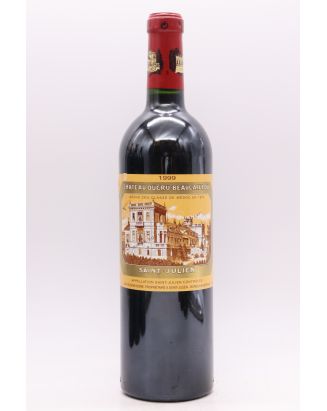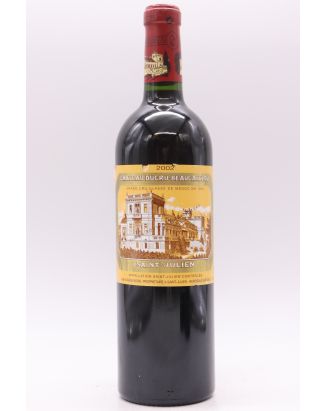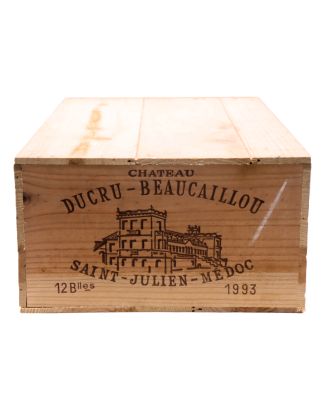












Château Ducru-Beaucaillou takes its name from the famous "beautiful pebbles" that make up its unique terroir. The estate was acquired in 1797 by Bertrand Ducru, a brilliant merchant who added his surname to that of the property. His ambition and investment in the vineyards quickly propelled Ducru-Beaucaillou to the top of the Saint-Julien appellation.
In 1855, during the famous classification of Bordeaux wines, the estate was classified as a Second Growth, a prestigious status it continues to maintain today. Over the decades, the château has passed through the hands of different families, including the Borie family, owners since 1941. Thanks to rigorous and passionate management, the estate has preserved and enhanced its heritage while adopting modern viticultural practices.
Robert Parker gave the 100/100 for the 1959, and 99/100 for 2010 and 1953 vintages of Château Ducru-Beaucaillou a score of 99/100, underlining their exceptional quality. The 2016, 2009, 1961 and 2018 vintages, rated 98/100, confirm the consistency of this Saint-Julien grand cru classé.
The exceptional terroir of Ducru-Beaucaillou, on the left bank, is one of the main assets contributing to the quality of its wines. The poor soils, consisting mainly of Günzian gravel, offer ideal conditions for cultivating the noble grape varieties of the Médoc. These quartz pebbles, carried by the ancient Garonne over two million years ago, promote excellent drainage of the vines, while storing heat during the day to release it at night, thus favouring optimal grape maturation.
Another major asset is the estate's proximity to the Gironde estuary. The latter acts as a thermal regulator, moderating extreme temperatures and protecting the vines from weather hazards such as hail or winter frosts. This unique microclimate allows the grapes to develop under ideal conditions, while limiting the need for phytosanitary treatments.
The grape varieties cultivated at the château are mainly Cabernet Sauvignon (70%), Merlot (25%) and Petit Verdot (5%), with vines averaging 40 years of age. This varietal diversity and the advanced age of the vines allow for the production of highly complex wines capable of improving for several decades.
Winemaking at Château Ducru-Beaucaillou is a true art, where each step is meticulously controlled to ensure the highest possible quality. The selection of grapes begins in the vineyard, with exclusively manual harvesting. A first rigorous selection is carried out directly in the plots, then a second sorting upon reception of the bunches at the winery, where optical sorting is used to remove imperfect berries.
Vinification is carried out in small, truncated cone-shaped stainless steel vats (60 to 80 hectolitres), which allows for separate vinification of each plot, or even micro-plot, to preserve the unique identity of each terroir. These vats allow for precise temperature control and optimise the extraction of aromas and tannins.
The wine is then aged for 18 months in French oak barrels, 50 to 80% of which are new. This long barrel ageing allows Ducru-Beaucaillou wines to develop complex aromas and a silky texture, while refining their tannic structure for optimal ageing.
Château Ducru-Beaucaillou offers three major cuvées, each embodying in its own way the excellence of the estate:
Château Ducru-Beaucaillou: The estate's Grand Vin, recognised for its elegance, depth and exceptional ageing potential. Blended mainly from Cabernet Sauvignon, it offers aromas of ripe black fruits, spices and tobacco, with silky tannins and a persistent finish.
La Croix Ducru-Beaucaillou: The château's second wine and previously known as La Croix de Beaucaillou, La Croix comes from specific plots in the vineyard. More accessible in its youth than the Grand Vin, it charms with its finesse and remarkable balance. La Croix Ducru-Beaucaillou is a blend of Cabernet Sauvignon, Merlot and Petit Verdot, offering notes of red and black fruits, with a beautiful tannic structure.
Le Petit Ducru : The estate's newest addition, Le Petit Ducru is a true initiation to the Ducru-Beaucaillou style. It offers a beautiful aromatic complexity with fruity and floral notes, a supple texture and melted tannins, perfect for tasting in its youth.
Saint-Julien, a flagship appellation of the Médoc in Bordeaux, is renowned for its red wines of great finesse and longevity. Certain vintages particularly stand out for their exceptional quality, offering powerful, elegant and complex wines. Among the finest vintages, one finds years such as 1975, 1982, 1985, 1986, 1989 and 1990, which are true benchmarks for connoisseurs of age-worthy wines. More recent years have not been left behind, with notable vintages such as 1995, 1996, 2000, 2003, 2005, 2008, 2009, 2010, and 2012, all praised for their balance and ageing potential. The years 2014, 2015, 2016, 2017, 2018, 2019 and 2020 also distinguish themselves through their richness and complexity, continuing to make Saint-Julien an essential reference in the world of wine.
The Second Growths of 1855 constitute a prestigious category, grouping together iconic estates that often rival the First Growths in quality. Among them, discover Château Brane-Cantenac and Château Durfort-Vivens, both located in Margaux, as well as Château Lascombes, Château Rauzan-Ségla, and Château Rauzan-Gassies. In Saint-Julien, wine enthusiasts will appreciate the wines from Château Ducru-Beaucaillou, Château Léoville Las Cases, Château Gruaud Larose, and the famous Château Léoville Poyferré and Château Léoville Barton. Don't miss Château Cos d'Estournel and Château Montrose in Saint-Estèphe, as well as the essential Château Pichon Longueville Baron and Château Pichon Longueville Comtesse de Lalande in Pauillac.
With a rich history, exceptional terroirs and unparalleled expertise, Château Ducru-Beaucaillou continues to establish itself as one of the jewels of the Bordeaux vineyard. Its wines, of rare elegance and fascinating complexity, seduce connoisseurs around the world. Whether for immediate tasting or to enrich a cellar, Ducru-Beaucaillou wines are an invitation to discover the best of Saint-Julien.